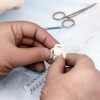Madi, Silvana MD; Leon, Pia MD; Nahum, Yoav MD; D’Angelo, Sergio MD; Giannaccare, Giuseppe MD; Beltz, Jacqueline MD, FRANZCO; Busin, Massimo MD.
Cornea: September 2019 — Volume 38 — Issue 9 — p 1192–1197
Abstract:
Purpose: To report 5-year outcomes of ultrathin Descemet stripping automated endothelial keratoplasty (UT-DSAEK) with a central graft thickness intended to be < 100 μm.
Methods: This retrospective, consecutive, interventional case series included 354 eyes with endothelial decompensation due to various causes (Fuchs endothelial dystrophy, pseudophakic or aphakic bullous keratopathy, failed previous graft, herpetic endothelitis, or buphthalmos). Donor tissue was prepared using the microkeratome-assisted double-pass technique aiming at a graft thickness < 100 μm. The Descemet membrane was stripped under air. The graft was delivered into the anterior chamber using the pull-through technique through a 3.2-mm clear corneal incision using a modified Busin glide. The best spectacle-corrected visual acuity (BSCVA), endothelial cell loss, graft survival rates, and immunologic rejection rates were evaluated.
Results: Follow-up data at 1, 2, 3, and 5 years after UT-DSAEK were collected from 214, 172, 147, and 105 eyes, respectively. After excluding eyes with comorbidities, BSCVA better than or equal to 20/20 was recorded in 36.3%, 37.4%, 46.4%, and 53.4% of eyes, respectively, whereas BSCVA better than or equal to 20/40 was documented in 95.5%, 95.3%, 96.0%, and 96.6% of eyes, respectively. The mean endothelial cell loss was 35.4%, 42.3%, 43.3%, and 52.3%; Kaplan–Meier graft survival probability was 99.1%, 96.2%, 94.2%, and 94.2%, and Kaplan–Meier cumulative probability of a rejection episode was 3.4%, 4.3%, 5%, and 6.9% at 1, 2, 3, and 5 years, respectively.
Conclusions: UT-DSAEK grafts allow excellent 5-year outcomes, including BSCVA, endothelial cell density, and survival rates comparable with those recorded post-Descemet membrane endothelial keratoplasty, but with a higher immunologic rejection rate.
Copyright © 2019 Wolters Kluwer Health, Inc. All rights reserved.












